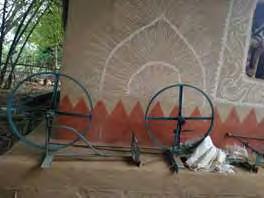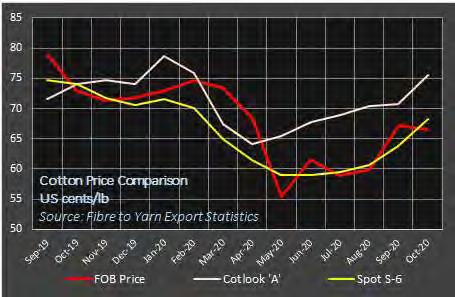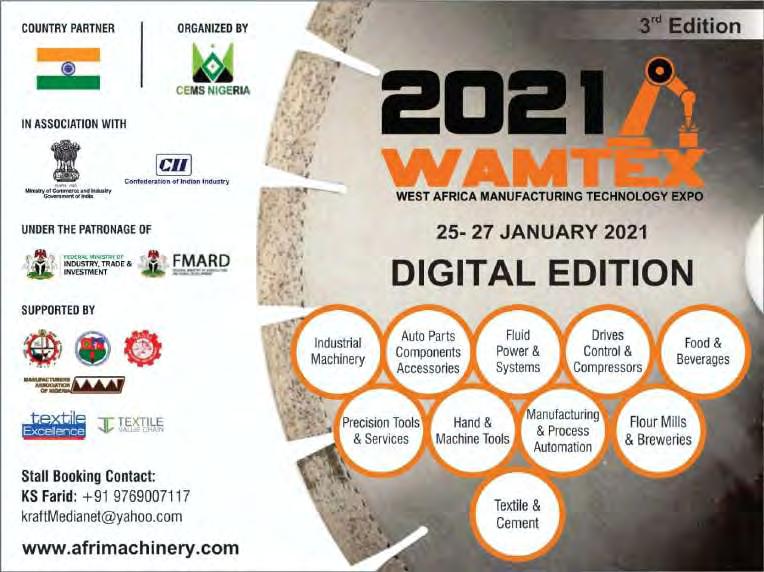
15 minute read
HANDLOOM
39 HANDLOOM SECTOR Biofabrication designs include Australia, pp. 581-595. headphones made from fungus and packaging of food made from algae. In the sphere of sustainability and environmentalism, food packaging has become a priority. Walk down any store aisle or look at your own [2] Abdel-Raouf N., Al-Homaidan A.A, Ibraheem I.B.M (2012). Microalgae and wastewater treatment. Saudi J. Biol. Sci. 19(3):257275. shopping cart, and you're likely to [3] Ahmad A.L, Yasin N.M, Derek see package after package made of C.J.C, Lim J.K (2011). Microalgae as plastic centred on petroleum. Bio- a sustainable energy source for biofabrication gives the next direction diesel production: a review. Renew. to create an algae-based alternative Sustain. Energy Rev. 15(1):584-593. to plastic, have chosen to address the problem. [4] Begum, H., Yusoff, F.M., Banerjee, S., Khatoon, H., and Shariff, References M. (2016) Availability and utilization [1] Sonja Hindrum, Bissember A. (2018). Growing and Bio-fabriof pigments from microalgae. 2209–2222. cating SCOBY, University of Sydney, [5] Odjadjare, E.C., Mutanda, T., and Olaniran, A.O. (2017) Potential biotechnological application of microalgae. 37–52. [6] Roya Aghighi, (2019). Ecofashion. Inhabitat.com [7] Briantais, J.M., Vernotte, C., Picaud, M. & Krause, G.H. (1979) A quantitative study of the slow decline of chloro-phyll a fluorescence in isolated chloroplasts. Biochim. Bio-phys. Acta. 548: 128–138. [8] Masojidek, J., Kopecky, J., Koblzek, M. & Torzillo, G. (2004) The xanthophyll cycle in green algae (Chlorophyta): its role in the photosynthetic apparatus. Plant Biol. 6: 342–349
A wholesome glimpse of handloom sector in the middle of market
Advertisement
Radha Gobinda Das, Goutam Bar
National Institute of Fashion Technology, Bhubaneshwar
Abstract Marketing is a gamechanger in case of the handloom sector. The middlemen have a crucial role in connecting the weaver to the consumer. The power loom has a major market share in India and have a core preference over the handloom sector, due to lack of proper marketing. The handloom retail have a smaller footfall rate usually, due to the ineffectiveness of marketing strategies. So, this report is intended to discuss the basic research problem that can have significant effect, at the end of the day. These four core players, when it comes to marketing are product, price, place and promotion related strategies. To make it easier to understand the relevance of marketing, on the basis of how the product has been assessed in the market, how the industry addresses its problems, what are the marketing strategy currently in run and why the development of handloom sector is still at stake, discussion of what can be done. The report will include four types of marketing strategies at different levels with respect to market efficiency and effectiveness in the handloom industry. Key words: handloom, marketing, effective and efficient commercialisation Introduction The market for handloom industry is also vast, like any other market. In order to have an understanding, it has been simplified by many researchers. In order to categorise the market, we can categorise it in four different parts such as the Village market, the self-consumption sector, the market in distance which is basically the urban market and the export market. In this entire structure, the monopoly players are where the master weavers are col-
laborated with the private retailers and that covers up around 90% of market offering. These products are usually traded directly at the trader’s retail houses or they are sold by other big-time intermediary wholesalers and the retailers. The other crucial fragment are the merchant exporters who sell the handloom products via their international connections with foreign buyers or their indirect connections at the big-time foreign retail houses. Now, the workforce in this industry can be categorised under organised and unorganised sector. There are 3 core players in the textile market, the handloom sector, the power loom sector and the textile mills. India has a really bigger market potential in the holistic growth, when it is about the Handloom sector, according to many researchers. A recent survey, it is accountable for 14% in the field of production, which makes a core contribution of 4% in the National Gross Domestic product (GDP) and also accountable for 13% of the Gross Total Export. Currently, India feeds around 95 per cent of world’s total handloom fabric demands. Especially, the handloom fabrics like ikats and the other handloom fabrics which needs utmost intricacy and detailed
Figure 1: The charkha HANDLOOM SECTOR 40 design intervention, produced in cost range and negligible energy the clusters of India has a vital role requirements. It has the potential to play in global export market.It is in the domestic market, the sector also an attraction for many foreign is exclusively financed by NABARD, consumers. the services to this sector is providLiterature Review ed through WSC, IIHT, NHDC, Textile Committee and HEP etc. There Indian handloom sector is definite- are even provisions from banks for ly result of its rich cultural heritage the availability of raw materials, of India. In the handloom secto,r designs, Apparel Park etc. The govwomen have a predominant role to ernment has provisioned welfare play in to pre-loom and post-loom schemes, textile policies and has inactivities. Related activities include augurated Handloom Reservation dyeing, finishing, winding, bleach- Act with the scope of upliftment in ing, and embroidery. Indian hand- the textile sector. There are actions looms have significantly different taken by the government to protect feature than in comparison to the the interest of the artisans such as handlooms of other countries in labor ethics including minimum many aspects. It has a definite bal- wages act, maintaining work ethics, ance of both tradition and moder- eco-friendly regulations etc. by the nity in a piece of fabric, it has an government. endless spectrum of colours in the palette which is the expression of heart and soul of Indian weavers, it is suitable looking at the design parameters with respect to the cultural relevance, ethical design and has definitely a traditional orientation. Now, inspite of all the worthy instances in the government policies, they are undermined and look for the loopholes. Even though the economy has the greatest potential, for the higher yield and productivity in the field of handloom and its The vast history and geography industry. There lies a missing line of of this territory, definitely adds all cross-checking and monitoring of that is said to be its strength and the how things are working in actufeatures. It is known as land of Cot- al. Now, in spite of all efforts by the ton, most of it cannot be replicated government, at central and state in power looms at a wider scale, it levels; there are problems related has the majority of skilled, semi- to the adequacy and qualitative skilled work force, incur a lower parameters of the raw materials. There is always a lack of managerial intellects, that are required, in order to meet the higher market sales. There has been a universal problem, that is applicable in almost all the clusters is that, there a lack of standardisation systems in the products. As there are no protocols followed in any cluster to maintain a range and balance in the homogeneity required in an order. Now, if there is design that makes a good place in the market, it takes more than enough time, for any cluster to accept any diversification and this doesn’t only go on the final products but also for the techniques, the machineries and the whole system. In some of the clusters there are even chemicals used to dye the yarns; which has been long banned. But the innocent artisans are expected to do so and are enslaved
HANDLOOM SECTOR to their fate or occupation. Even, in some the clusters situated in the remote locations, there are problems like non-viable organisations that have a core role to play in the operational activities in the cluster. There are often, after-production costs that goes unnoticed. For example, there are no stock houses to keep the over produced products that go in the dead stock every year. Sometimes, this is due to heavy pricing and uncontrollable overheads. The policies, welfare schemes and the Handloom Act are there to ensure the pre-staged interests of the handloom workers. But due to the unnoticed monitoring of its implementation, it has given rise to some threats, that government now needs to see. There are several threats to this industry, which is corroding its future away, at this moment. In almost every cluster in this twentyfirst century the weavers are migrating to other trades. Even some of the well earning weavers are very aware of the very uncertainties, so they do not forsee their next generations involve in what they do. There is always a clash of design ideology, lack of design thinking and sensitivity in almost all the clusters, which has given it a heavy competition. In the power loom industries, the power looms have a technological upper hand to imitate the designs of the handlooms. The final products from the handloom industry often is not at an upper hand in the final pricing in the global market due to low maintenance of product standardisation. The weavers are at a crisis to realise and care about using eco-friendly elements in their production process which gets a tough competition with the mass-produced products in the market. According to a survey, 99% of the rural producers are unaware of the LPG ( liberalisation, privatisation, globalisation). There is a very under-maintained cohesion in the rural institutions, which acts as a potential threat to the existence of the handloom-clusters. Market study and trend analysis: Now, the traditional structure of market with holding the idea of production will drive consumption has changed to, consumers will rule over what to be produced! Now, everything starts with a market research at firs,t then it goes under the design process to come up with a set of prototypes or a prototype. Once the prototype is produced it goes through the closer inspection of the consumer panel and is rectified according to the reactions and scanned feedback, after which it goes for the final commercialisation and advertisement. Followed by the market demand analysis USA (United states of America) is evident to be the biggest client for Indian textile products, with an estimated amount of $5.321 trillion during 2014, with a rise of 5% for the year from $4.0 trillion during 2009. Even the smaller countries in Asia for e.g. Malaysia initiated with an import order of US$ 0.85 Million from India during 2009-2010. But presently, there is a crucial market in the centres points abroad. Europe is the second biggest client country and other smaller countries. Even if we compare our hourly labour wages with other countries, it is comparatively more than at 22 among 25 countries with Rs. 67/ hour, where Switzerland has the maximum pay for per hour labour cost of Rs. 3300/hour and America with Rs. 1008/hour but its more than other Asian countries such as Pakistan, Cambodia, Indonesia, Philippines and Bangladesh. Discussion The Indian handloom sectors have seen the hardships and the good times. The government has taken many steps thorugh the welfare schemes, policies and acts such as Janata Cloth Scheme, Textile Policy-1985, Handloom Reservation Act-1985 and Hank Yarn Obligation scheme. But now, it is time that the government has to rethink beyond creating co-operatives. Now, it is the time that government has to make necessary steps in making these weavers as the next generation exporters. If we go by the data analysis and the studies, the handloom industries should target the global market to have a better life, than just being sufficient. There are even bigtime clusters, those with a potential of selling their products directly in the global market, so the government should look more into finding ways to boost sales and export at various clusters. There should be a provision for the creation of State level export cell where there could be trend analysis reports, the style study, the color study and even the material analysis. There should be more involvement of the clusters in the international exhibitions and competitions, which can boost the exposure and the diversification, scope for the weavers. The weavers should come up with such designs which can not be replicated by any power looms and which can also obtain a good amoun,t in the final market and pay off the craftmanship of the weavers at the same time. Now, it has been a common problem of scarce availability of wider looms in many clusters which becomes very essential in creating home products such as bedsheets and curtains. Apart from these, the product tagging or Trademark approvals should be provided to the final products so as to get extra willingness from the international consumers. The clusters should give much focus and restriction on using eco friendly materials. Lastly, the deadstock disposal should be avoided at all costs. Conclusion India always has the potential to produce the 95% of the world’s handloom products but now its not being sufficient to pay our weavers and artisans involved in this sector. The times ae such that there are specific threats which has shaken the future prospects of its existence due to certain negligence we have discussed above but with the necessary steps taken it can be taken from the family trait to the passion of the next generation of weavers. The handlooms are worn usually on occasions which seem more like just a hope for its existence. But that is not the real solution because
COVER STORY YARN REPORT of many reasons. So, it is high time for the sector to identify its market and maintain the standards to keep pace with all the different perspectives. Reference 1. Martin M (2013) Impact Economy, 2013, Creating sustainable apparel value chains: a primer on industry transformation. Suisse: Impact Economy. 2. Handloom Mark : www.hand-
Basic textiles comprising fibres, spun and filament yarns shipment in October was up 22% YoY in terms of US$ worth US$575 million or INR4,178 crore, accounting for about 2.3% of total merchandise exported from India during the month. The increase was mainly a recovery of sharp decrease of 26% seen in October 2019. Even compared with previous month, the increase was a mere 7%. Spun Yarn Yarns export or shipment totaled 109 million kg worth US$289 million or INR2,102 crore. They were 5% higher than October 2019 in terms of volume and just 1% up in terms of US$. Bangladesh was the largest importer in spun yarns with value up 11%, followed by China (-16%). These two markets accounted for about 35% to total yarn shipment during the month. Cotton yarn export was 88 million kg worth US$238 million (INR1,731 crore). These were shipped to 78 countries at an average price of US$2.72 a kg, up US cents 66 from previous month but US cents 8 down loommark.gov.in/ 3. Behera, S. ‘Globalization process!!! A boon or curse for Indian Handloom Industry??’, ‘All India seminar on sustenance of handloom sector in the era of globalization’, 7-8, August, 2009, Bhubaneswar, (IEI), Orissa, p-44-45 4. Buhler, A. Fischer, E. and Nobholz, M. L. Indian Tie – Dyed Fabrics (Vol.4, 1980), P.20
Nitin Madkaikar
from a year ago. Bangladesh was the top cotton yarn market, followed by China, Peru, Portugal and Vietnam. 100% man-made fibre yarns exports of 7.49 million kg, comprised 3.23 million kg of polyester yarn, 2.07 million kg of viscose yarn and 1.76 million kg of acrylic yarn. Polyester yarn export was worth US$6.6 million or INR48 at an average price of US$2.04 per kg in October. USA was the largest market followed by Brazil and Turkey. Viscose spun yarns export was worth US$6.39 million and were exported at an average unit price of US$3.08 a kg. Bangladesh was the largest importer of viscose yarn, followed by Turley and Iran. Blended spun yarns worth US$33 million were exported in October, including 10.2 million kg of PC yarns and 2.3 million kg of PV yarns. Peru was the largest importers of PC yarn from India followed by Peru while Turkey was the largest importer of PV yarns from India followed distantly by Brazil. Cotton Cotton export shipment in October, the first month of new 2020-21 mar5. Mohanty, B. C. and Krishna, K. Ikat Fabrics of Orissa and Andhra Pradesh (Vol. 1, 1974, Calico Museum of Textiles, Ahmedabad, India), P. 18. 6. Mohanty, B. C. and Krishna, K. Ikat Fabrics of Orissa and Andhra Pradesh (Vol. 1, 1974, Calico Museum of Textiles, Ahmedabad, India),
Yarn export flat in October, cotton gets a good start
P. 15 keting season, surged four times compared to last year in volume at 6.84 lakh bales worth INR1,238 crore or US$170 million. This was a good start to the season, as they were also doubled even compared with the first month of 2018-19 season. The 2019-20 season (Oct-19 to Sept-20) had ended with export of 61.84 lakh bales worth US$1,580 million or INR11,368 crore. Bangladesh was the largest market for Indian cotton export during October, followed by China and Vietnam. No shipment was reported to Pakistan during the month. Export price realisation for cotton averaged INR106 a kg or US cents 66.50 per pound during October. This was below Cotlook A index, the global spot price benchmark also compared with domestic spot price for benchmark Gujarat Shankar-6. During the month, Cotlook averaged US$75.51 per pound and Shankar-6 at US cents 68.33 per pound, making Indian cotton more competitive in global market. Bangladesh imported Indian cotton at an average prices of US cents 68.56 per pound in October 2020 as against US cents 75.97 per pound a year ago. About 97% of its imports
consisted 28.5-34.5 mm length cotton. In similar comparison, China import was slightly lower at US cents 65.63 per pound since its import of 28.5-34.5 mm length was below 95%. Realisation from Vietnam was US cents 64.21 per pound, since 91% of its import was of 28.5-34.5 mm length and about 2% of <20 mm length cotton.












